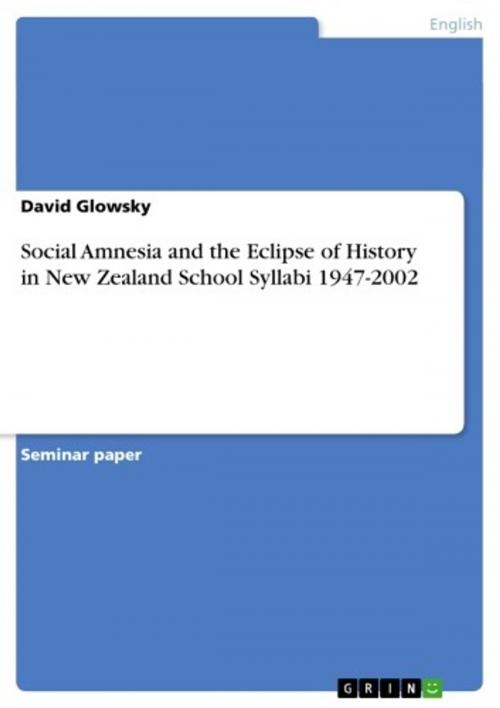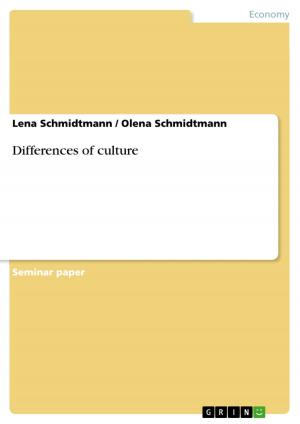Social Amnesia and the Eclipse of History in New Zealand School Syllabi 1947-2002
Nonfiction, Reference & Language, Study Aids, ESL, Foreign Languages| Author: | David Glowsky | ISBN: | 9783638241687 |
| Publisher: | GRIN Publishing | Publication: | January 4, 2004 |
| Imprint: | GRIN Publishing | Language: | English |
| Author: | David Glowsky |
| ISBN: | 9783638241687 |
| Publisher: | GRIN Publishing |
| Publication: | January 4, 2004 |
| Imprint: | GRIN Publishing |
| Language: | English |
Seminar paper from the year 2002 in the subject English Language and Literature Studies - Culture and Applied Geography, grade: 1,3 (A), Victoria University of Wellington (Robert Stout Research Centre), course: MNZS 511 Contemporary New Zealand, 20 entries in the bibliography, language: English, abstract: This essay analyses the content of the New Zealand Social Studies and History syllabi of the past 55 years. It concentrates on the one hand on content that refers to race relations in the country, to see what information was included or excluded to draw a certain picture of race relations; on the other hand it looks at how New Zealand interprets its links to other countries, to find out where it places itself culturally and politically in the world. It looks for patterns within the curriculum content that indicate certain ideological directions at the time the curricula were written, and for changes in these patterns over time. The underlying assumption here is that 'any school curriculum, regardless of its composition, is invariably a political instrument.' Openshaw and Archer have shown that even Social Studies, which have been regarded as unbiased and value-free, are as indoctrinated as history syllabi of the early 20th century. The main objective of Social Studies since its introduction in 1947 has not been to teach history. With little changes in formulation its aims have been to prepare children for life in New Zealand society, to introduce them to democratic institutions and make them eligible citizens. History as such plays a minor part in this. In 1986, Ann Low-Beer, a visiting British historian, reported that the majority of Social Studies teachers had no training in history, and historical material like primary resources hardly existed. The framework of Social Studies in the 1980s, like today, was sociological, based on general conceptions of human nature and interaction. Low-Beer's survey of teachers in 15 Wellington Junior schools asked whether students at the end Form 4, that is at the end of the compulsory Social Studies course, had an overall view of New Zealand human history. The responses made clear that ''Social Studies is about the present' and a picture of New Zealand [sic] past 'is not the point of the course''. According to the teachers, after eight years of Social Studies the pupils had 'no idea', they knew 'not even the basics like the names of Prime Ministers this century' and it was 'best to assume total ignorance of history in all pupils entering Form V'.5 Pupils thought similar about this issue. Keen found in 1977 that only 25% of older pupils felt that Social Studies had given them any insight into history.
Seminar paper from the year 2002 in the subject English Language and Literature Studies - Culture and Applied Geography, grade: 1,3 (A), Victoria University of Wellington (Robert Stout Research Centre), course: MNZS 511 Contemporary New Zealand, 20 entries in the bibliography, language: English, abstract: This essay analyses the content of the New Zealand Social Studies and History syllabi of the past 55 years. It concentrates on the one hand on content that refers to race relations in the country, to see what information was included or excluded to draw a certain picture of race relations; on the other hand it looks at how New Zealand interprets its links to other countries, to find out where it places itself culturally and politically in the world. It looks for patterns within the curriculum content that indicate certain ideological directions at the time the curricula were written, and for changes in these patterns over time. The underlying assumption here is that 'any school curriculum, regardless of its composition, is invariably a political instrument.' Openshaw and Archer have shown that even Social Studies, which have been regarded as unbiased and value-free, are as indoctrinated as history syllabi of the early 20th century. The main objective of Social Studies since its introduction in 1947 has not been to teach history. With little changes in formulation its aims have been to prepare children for life in New Zealand society, to introduce them to democratic institutions and make them eligible citizens. History as such plays a minor part in this. In 1986, Ann Low-Beer, a visiting British historian, reported that the majority of Social Studies teachers had no training in history, and historical material like primary resources hardly existed. The framework of Social Studies in the 1980s, like today, was sociological, based on general conceptions of human nature and interaction. Low-Beer's survey of teachers in 15 Wellington Junior schools asked whether students at the end Form 4, that is at the end of the compulsory Social Studies course, had an overall view of New Zealand human history. The responses made clear that ''Social Studies is about the present' and a picture of New Zealand [sic] past 'is not the point of the course''. According to the teachers, after eight years of Social Studies the pupils had 'no idea', they knew 'not even the basics like the names of Prime Ministers this century' and it was 'best to assume total ignorance of history in all pupils entering Form V'.5 Pupils thought similar about this issue. Keen found in 1977 that only 25% of older pupils felt that Social Studies had given them any insight into history.















